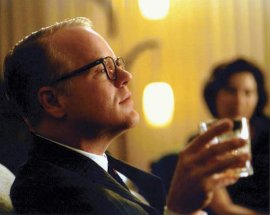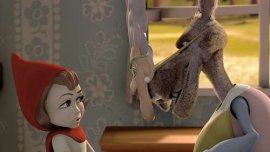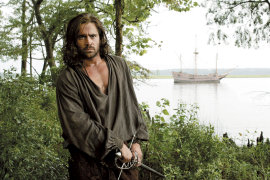 CAPOTE
CAPOTE
When I first saw Bennett Miller's Capote back in November, I was so knocked out by Philip Seymour Hoffman's portrayal that I fear I may have undervalued the movie itself; Hoffman's channeling of this singular author was so extraordinary that, although the film itself wouldn't fit anyone's definition of "feel-good," I'm not sure I stopped smiling once through its two-hour running length. (Performances of this quality have a way of putting me in a fantastic mood, regardless of a movie's subject matter.) But on a return visit to Capote this past weekend, I was able to more fully luxuriate in the brilliance of its design and the strength of its presentation; what could have been a "mere" performance piece proves, in the hands of Miller and screenwriter Dan Futterman, to be a work of rare artistry and depth. Capote is so beautifully crafted - thematically rich, psychologically insightful, and mordantly funny - that you might be embarrassed by what a fine time you're having at it.
Capote begins with the 1959 murders of a Kansas family at the hands of Dick Hickock (Mark Pellegrino) and Perry Smith (Clifton Collins Jr.), and follows the six-year journey it took for celebrity author Truman Capote (Hoffman) to turn the horrific story into his crime classic In Cold Blood. As Capote, aided by childhood friend and eventual To Kill a Mockingbird author Nelle Harper Lee (Catherine Keener), insinuates himself into the Holcomb, Kansas, community, what begins as a lark - a way for Capote to reach further pinnacles of success through a new literary form, the "nonfiction novel" - turns into an obsession, especially when the stout, flamboyant author with the sing-song voice begins to probe deeper and deeper into the whys behind the killers' heinous act. Capote strikes an arrangement, and even a wary friendship, with Perry - the killer agrees to interviews in exchange for the author's aid in securing an appeal - and Capote becomes a tense cat-and-mouse game wherein both participants are the cat, ever-primed to pounce and devour.
In the end, of course, Capote was the victor in this battle of wills; Hickock and Smith were eventually executed, and In Cold Blood made its author a legend. But the film's genius lies in showing how the experience destroyed all three men - Capote, undone by drink and implied self-loathing, never finished another book - and any writer who has experienced the tenuous relationship between author and subject might view Capote with a fierce shudder of recognition. There can be no denying that Capote, here, is oftentimes a monster; when asked if he holds Smith in esteem, Capote (who, in the previous scene, has convinced the killer that they are, in fact, dear friends) says, "He's a gold mine." But he's a monster you understand. The author has been shaped by Miller and Futterman with such trenchant depth that you're riveted by Capote even when his actions are reprehensible - nice guys very rarely create art - and the film gets at the writing process with more acuity than I've ever before seen; Capote's burgeoning, breathless delight at just how good In Cold Blood might eventually be is as marvelously detailed as the author's frustration with the personal toll its creation is exacting. Through spectacular composition and editing, Miller creates a world in Capote that's bleak and terrifying, and you fully grasp the author's need to have the entire experience over and done with; he's creating a masterpiece but losing his soul, and the trajectory is hypnotic to watch.
The filmmaking is so admirable, so emotionally and intellectually complex, that Capote would almost certainly have succeeded even with another actor in the title role. But I'm thrilled that the point is moot; for those of us who have followed his screen career with active interest since his 1992 Scent of a Woman debut - when many of us stuck through the closing credits just to find out who that was playing Chris O'Donnell's smarmy prep-school antagonist - Capote is the Hoffman showcase we've been waiting for. Nothing about Hoffman's performance feels like a stunt. Every pause, gesture, and line reading is suffused with interior life; in lesser hands, a full-length Capote imitation could be tiresome or even laughable, yet Hoffman is positively triumphant. (The role of Capote, here, is like Lear with a Bergdorf's scarf.) The movie is filled with terrific supporting work - Keener, Collins, Chris Cooper, and Bob Balaban are especially noteworthy - but Hoffman is nearly beyond praise; in Capote, he turns an impersonation into something more akin to alchemy.
 HOODWINKED
HOODWINKED
There's absolutely nothing cutesy about the independent animated release Hoodwinked, and that's what I loved about it. Presenting the Little Red Riding Hood story through four separate viewpoints - that of Red (voiced by Anne Hathaway), her grandma (Glenn Close), the wolf (a hysterical Patrick Warburton), and a German lumberjack (Jim Belushi) who, bizarrely, drops into the tale - writers/directors Cory and Todd Edwards and Tony Leach fill their fairy-tale Rashomon with so many levels of wicked, comic inspiration that the movie becomes rather dizzying; the jokes fly so fast and furious that Hoodwinked doesn't have time for "heart," for which I was thankful. (Even the heroine's token, sappy pop ballad turns into a deliciously funny in-joke.) The low-grade animation takes a little getting used to - there's a droopy nonchalance to many of the characters' movements, as if they were occurring underwater - and the plot wraps up rather predictably. But I laughed out loud a good two dozen times at the movie's throwaway cleverness (a visual reference to The Sound of Munich positively killed me), the storyline is charted with supreme skill, and the characters possess a manic delirium that would do Tex Avery proud - it's only January, but I'm not sure you'll find bigger laughs this year than you will with Hoodwinked's over-stimulated squirrel, who's like the Tazmanian Devil on a triple espresso.
 THE NEW WORLD
THE NEW WORLD
I realize that Terrence Malick is an artist. I understand that he's a genius with light, sound, and composition. I know that his works - the last being 1998's Guadalcanal meditation The Thin Red Line - are often referred to by serious film scholars as "tone poems," and that they aren't meant to provide much in the way of traditional narrative. I recognize that his characters' ethereal voice-overs are less literal pronouncements than expressions of the soul. And I readily cede that Malick's latest work, The New World - which follows Pocahontas (the lovely, naturalistic Q'orianka Kilcher), John Smith (Colin Farrell), and Smith's cadre of English settlers in the early days of America's colonization - is never less than stunningly beautiful. It pays exquisite attention to the pas de deux between sunlight and shadow, and, with his camera swooping through the tall grass just behind our protagonists, Malick's trademark tracking shots are models of hypnotic grace and control.
I acquiesce to all of this.
It's just that the movie is so damned boring I wanted to blow my brains out.










